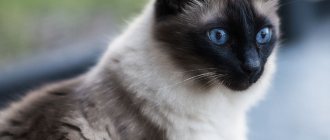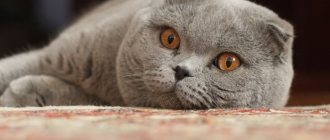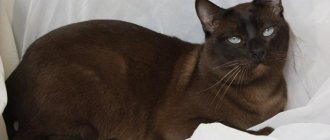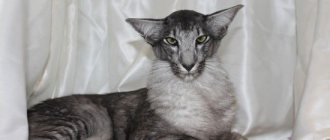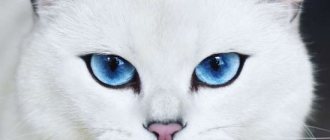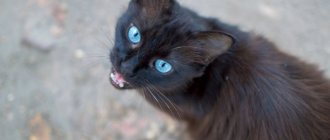Brief history of the breed
America is considered the birthplace of the Balinese. According to one version, they appeared as a result of a gene mutation. According to the second theory, Balineses were bred as a result of mating Angora and Siamese cats.
Serious work on creating a new breed began in 1950 on the initiative of Marion Dorset. Ten years later, Helen Smith joined her and suggested calling the resulting cats Balinese.
For a long time, the breed did not receive official recognition from the public. It was possible to register the Balinese only in 1970 thanks to the persistence and tenacity of the breeders.
Interesting Facts
Although Balinese cats appeared relatively recently, they managed to associate a lot of interesting things with the breed:
- The name of the animals has nothing to do with the area where they were bred. It is associated with the appearance of cats, which with their grace resemble Balinese dancers.
- The color of the coat of representatives of this breed is influenced by a special gene, the activity of which changes with cold weather. Therefore, it is better to keep Balinese dogs in warm rooms with an air temperature of 22-24 °C.
- Kittens of this breed are born with short hair. The guard hair lengthens as the Balinese matures.
Breed description, standards, appearance
The Balinese cat has a graceful, athletic build and well-developed muscles. Visually, it is very similar to the Siamese, only with longer hair. The first breed standard appeared in 1967. It regulates not only the exterior, but also the behavioral characteristics of the Balinese.
Dimensions and weight
Representatives of the Balinese breed are not large animals. Females weigh on average 3.5 kg. Cats of this breed are heavier: the body weight of an adult male is about 5 kg.
Anatomical characteristics
Pedigree Balinese cats must meet the following description:
- The head is small, wedge-shaped with a narrowed, elongated muzzle, straight profile, pointed chin, high prominent cheekbones and a strong lower jaw.
- The eyes are almond-shaped, expressive, and slanted. The color of the iris is blue or blue.
- The ears are triangular, erect, disproportionately large. They have rounded tips and are a harmonious continuation of the wedge-shaped head.
- The body is stretched, slender with well-developed muscles.
- The limbs are thin, long with small oval paws. The front ones are slightly shorter than the rear ones.
- The tail is thin and long. Visually resembles a whip. Decorated with plumes.
Color and coat type
The body of a Balinese cat is covered with shiny, silky hair. On the chin, tail and neck of the animal, the hair is slightly wavy.
The colors of the Balinese can be varied. The most common colors found in the breed are:
- frost point;
- brown (chocolate) point;
- seal point;
- blue point;
- tabby
On a note. Balinese kittens are born with a uniform coat. The formation of color is completed by 12-18 months.
Possible breed defects
The disadvantages of the exterior of Balinese cats include:
- strabismus;
- kinks on the tail;
- dark spots on the stomach;
- white fingers;
- lack of markings on paws and muzzle;
- solid black or red color.
Balinese dogs with at least one of the above defects are not allowed for exhibitions and are not used for breeding.
Beware: scammers!
Many gullible buyers find offers from scammers who offer such a curiosity as a Balinese cat more tempting to buy for almost five hundred rubles. Any fluffy color-point kitten can be passed off as a Balinese baby. It could be a defective mustache from a Siamese litter, or a completely outbred tailed cub.
Only an experienced specialist can distinguish the “original” from the “fake”, and therefore the main advice to inexperienced breeders: be sure to show the potential pet to a knowledgeable person. Of course, it’s easier to do this if you buy a kitten at an exhibition, where you can seek advice from an expert on the spot.
Also, don’t rely on Matroskin the cat’s introduction: “Whiskers, paws and tail—these are my documents!” A Balinese kitten must have real documents.
In addition, the buyer has the right to look at the pedigree of the mustachioed mom and dad, find out the exact contacts of the club in which the parents' breeders are registered, and even make an appointment there for a personal acquaintance.
Character and temperament
Balinese cats are sociable, curious and intelligent creatures. Thanks to their natural flexibility and acrobatic abilities, they can easily climb tall cabinets and other hard-to-reach places in search of interesting objects.
Balinese cats need constant communication with people and love to be the center of attention. They quickly become attached to their owners and do not tolerate loneliness well.
Balinese cats are not as violent and selfish as their Siamese relatives. By temperament type, representatives of this breed are true sanguines.
Balinese are energetic, active animals that never get discouraged.
Breed and children
The Balinese cat gets along well with the owner's kids. Especially if children understand how to properly communicate with a pet and do not offend it.
He will be happy to play with them. But if the kids start squeezing the Balinese or carrying it in their arms, the cat may show its claws.
Breed and other animals
Balinese cats have always lived close to people and never foraged for food in their natural environment. Therefore, they do not have developed hunting instincts and are calm towards other animals.
Balinese cats get along well with a variety of pets, from dogs to rodents.
Positive and negative points
Every year Balinese cats become more and more popular. Cute, playful and loyal, they are a favorite for single people and families with children.
Positive aspects of this cat:
- grace and grace;
- calm character;
- love for people;
- lack of aggressive attitude towards children;
- ability to educate and train;
- intelligence and intelligence;
- cleanliness;
- unpretentiousness.
Before buying a cat of this breed, you need to consider the following:
- The Balinese cat cannot stand being alone. She should not be left alone for a long time. Therefore, it is better not to get such a cat for people who are often away from home for a long time.
- Balinese does not tolerate aggression and quarrels. In such cases, it often changes its character and becomes similar to its owner.
- Pets meow often and loudly.
How to choose the right kitten
Balinese cats are a fairly rare breed. Therefore, it is better to buy such an animal in a specialized nursery or from a professional breeder with a good reputation. Before purchasing a small Balinese, you need to read the documents and look at the conditions of its maintenance.
A healthy kitten is large, active and very mobile. He shows no fear and is interested in everything that happens around him. The little Balinese has a soft belly, clear, non-squinting eyes, pink gums, an even tail without knots or creases, clean skin and fresh breath.
Kitten care
A small Balinese requires more attention than an adult animal. Usually he gets into a new home no earlier than 3 months of age and by this time he is already accustomed to the tray and scratching post.
To make caring for your pet easier, before his arrival, purchase:
- bowls for food and water;
- bed or house;
- tray and filler;
- scratching post;
- carrying bag;
- toys;
- cosmetics (shampoo, toothpaste, etc.).
To prevent the tailed pet from causing trouble in the future, it is immediately taught the rules of behavior in the house and hygiene procedures.
Tips for choosing a kitten
The pattern on the coat of Balinese kittens takes about a year to form. To avoid being scammed, do not purchase animals from dubious places. Choose trusted nurseries that are ready to provide documents for their children. The higher price in such institutions is explained by the presence of a pedigree and a mandatory veterinary passport, which exclude the sale of mixed breeds or sick animals.
When you meet, evaluate the baby’s appearance and behavior. Also, do not forget to meet his parents and check the conditions of detention. If the entire cat family is healthy, active and kept in a clean room, feel free to choose any of the kittens.
Care and maintenance
Representatives of the Balinese cat breed do not have an undercoat, which provides reliable protection from the cold. Therefore, they are completely unsuited for life on the street and are suitable exclusively for indoor keeping.
Caring for Balinese cats is not particularly difficult and comes down to proper feeding and hygiene.
Hygiene procedures
In order for the Balinese cat to look aesthetically pleasing, it is provided with appropriate care:
- The animal's eyes and ears are regularly wiped with a moistened cotton pad and inspected for unusual discharge. If balinese pus is detected, be sure to show it to a veterinarian.
- To prevent plaque and tartar from forming on your cat’s teeth, they are cleaned weekly with a silicone brush and a special paste that does not foam.
- Although Balinese dogs grind their nails down on their own, they are trimmed regularly to keep them looking well-groomed.
Grooming
To prevent the Balinese cat's fur from becoming tangled, it is combed several times a week with a special comb. During molting, the procedure is carried out more often than usual in order to speed up the loss of dead hair and the growth of new integument.
Since Balinese cats take care of the cleanliness of their coats on their own, they do not need frequent washing. Cats of this breed are bathed 2-3 times a year. The procedure is carried out in a warm room, away from drafts.
The wetted Balinese wool is lathered with a special shampoo and then rinsed with non-hot water. The bathed cat is thoroughly dried with a towel.
On a note. A hairdryer can dry out the silky Balinese coat. Therefore, it is better to refuse its use.
Tray
Balinese cats are not large animals, so both open and closed trays are equally suitable for them. But the choice of filler must be taken with special responsibility.
It must be of high quality and have good absorbent properties. Low-quality mineral or wood fillers are not suitable for long-haired Balinese. Such granules quickly become soaked and turn into an incomprehensible substance that sticks to the cat’s tail and paws and spreads throughout the house.
Education and training
The high level of intelligence inherent in the breed greatly simplifies the process of training its representatives. Balinese dogs quickly socialize, easily adapting to changing living conditions, and are excellent at learning new material. Experienced breeders recommend talking to the kitten as much as possible, explaining any actions - this approach works much better than dry commands. By the way, about commands: Balinese are so smart that they are able to recognize the meaning of more complex calls than the banal “kitty-kitty”. For example, almost all pets know their own names and respond to them. Moreover, some cat owners agree to remember up to three different nicknames and respond to each, which is considered an almost unique phenomenon.
Balinese cats are pliable and readily absorb information presented by their owner. They make it easy to learn funny tricks and play sports. In particular, the breed demonstrates good results in cat agility, which it perceives as a fun game. So if you come across a pet with a defect that does not allow you to compete at breed shows, such competitions will be an excellent alternative to performing in the ring, because not only purebred and show pets, but also any healthy cat can participate in them.
Balinese are excellent psychologists who masterfully read the owner’s emotions, so their habits are easier to correct. For example, cats quickly get used to all sorts of restrictions and try to follow them as best they can. For the same reason, there is no point in applying serious punishments to Balinese fluffies. It is better to take a four-legged hooligan to scare him. The cat climbed onto the table - sneak around the corner and spray it with water from a flower sprayer. Balinese has gotten into the habit of sharpening his claws on your favorite chair - treat the fabric with lemon or orange essential oil so that the smell disgusts your pet.
When instilling behavioral norms in your kitten, always remember about the character traits and habits of the breed. For example, if your pet toilets in a place not intended for this, do not punish him, but first check the litter box. Balinese cats are perfectionists when it comes to cleanliness and will not relieve themselves a second time in stale litter. It is pointless to scold this animal and try to retrain it, so either clean the tray after each such “trip”, or give up your dream of owning a Balinese.
Feeding the cat
Not only its health, but also its appearance depends on the quality of the Balinese’s diet. In order for the cat to develop properly and have beautiful fur, it is provided with a balanced menu.
Complete diet
It is most convenient to give your Balinese cat premium or super premium industrial food. It contains all the vitamins and microelements necessary for the normal development of the pet.
The main thing is that it does not contain dubious additives such as soy, dyes or flavor enhancers. These requirements best meet:
- Royal Canin;
- Acana;
- Pronature.
When feeding a Balinese cat with natural products, the diet is designed so that different types of meat predominate in it. The animal is also given:
- porridge;
- vegetables;
- eggs;
- dairy products.
It is strictly forbidden to treat Balinese with sweets, river fish and leftovers from the master's table.
Important! Contrary to popular belief, an adult Balinese cat should not be given fresh milk. It can cause indigestion in the animal.
Feeding frequency
A kitten of this breed eats little by little, but often. Therefore, the frequency of meals depends on the age of the balinese:
- up to 6 months – 4 times a day;
- 6-12 months – 3 times a day;
- over 12 months – 2 times a day.
Vitamins and minerals
It is advisable to give a Balinese cat that eats natural food additional vitamins twice a year. The use of such complexes helps to activate hair growth, improve skin condition and strengthen the animal’s bones.
They are selected taking into account the individual needs of a particular balinese and given in dosages recommended by the veterinarian.
Best suited for Balinese cats:
- 8 in 1 Excel Brewer's Yeast;
- Beaphar Kitty's Mix;
- Canina Canivita;
- Polidex Immunity up.
Features of feeding and diet
Knowing how much your pet should weigh, you can easily avoid its obesity. In most cases, the Balinese's weight is tracked only for general statistics, since a good metabolism prevents him from gaining weight.
Despite having no problems with excess weight, these cats love to eat, so they will have to be protected from stomach upsets. To do this, you just need to check with your veterinarian what and how many times to feed your pet.
The easiest and most affordable way of feeding is using dry food. Depending on the quality of the ingredients included, they are divided into 4 classes:
- economy;
- premium;
- super premium;
- holistic.
The owner himself chooses what food to feed his furry pet, but it is better to stick to one of the last 3 options. In the first case, manufacturers use low-grade raw materials. Due to insufficient nutritional value of the diet, the animal’s immunity suffers, which increases vulnerability to infections. Also, cheap food often causes allergic reactions and intestinal disorders.
Lines of industrial feeds are oriented by breed, age, pregnancy and disease. This helps to choose nutrition based on the individual characteristics of the balinese.
When choosing “natural” it is more difficult to achieve a balanced diet. Here you cannot use the standards indicated in the table of the guide for feeding kittens and adult animals. To obtain enough vitamins, the animal will need special supplements, which must be prescribed by a veterinarian.
Adult pets over 1 year old are fed twice a day. This norm is gradually reached from 2 months, when the baby is fed at least 6 times. In the future, the number of feedings can be increased if the pet is on a diet. In this case, the frequency increases in favor of smaller portions. This helps reduce stress on the stomach and reduce stress due to a reduction in usual volumes.
Health and susceptibility to disease
Balinese cats are strong animals with good immunity. With proper care, representatives of the breed live 15-20 years and remain active for a long time. But, like any other cats, Balinese cats are prone to certain health problems.
Most often found in the breed:
- bronchial asthma;
- dysplasia of the elbow and hip joints;
- diabetes;
- gingivitis;
- amyloidosis of the kidneys and liver.
Nutrition
The Balinese cat is not capricious when it comes to food, but a balanced diet is the key to the health of your furry pet. The menu should be varied and healthy.
The following products are used for preparation:
- different types of raw lean meat (necessarily well frozen);
- fresh heart;
- liver;
- egg yolks;
- kelp;
- fish fat;
- plantain seeds;
- vitamins B and E;
- water.
Cooked food is placed in containers and put into the freezer. When defrosting, do not use a microwave oven. The food is heated in a cup of warm water. For constipation, you can add pureed vegetables to your diet.
It is important that your cat always has fresh water.
Vaccinations and antiparasitic treatments
To protect the Balinese cat from viral and infectious diseases, it is regularly vaccinated. To do this, a complex drug is introduced into the pet’s body to provide protection:
- from rhinotracheitis;
- viral leukemia;
- calcivirosis;
- panleukopenia;
- rabies.
The first vaccination of the Balinese is carried out at the age of 8 weeks, and the further schedule is agreed upon with the veterinarian. Vaccination is given only to completely healthy animals that have undergone preliminary antiparasitic treatment.
The Balinese cat is protected from fleas using a collar, drops or shampoos. They are used strictly according to the instructions on the packaging.
To get rid of internal parasites, the Balinese cat is given anthelmintic drugs every 3-4 months, repeated every 10-12 days.
Diseases
This breed is in good health - alas! – can’t boast. The most common ailments:
- Strabismus (this problem can be obvious or smoothed out, but one thing is known: you cannot get rid of it);
- Cutaneous asthenia is a pathology in which the skin becomes so thin that it is injured even with normal movement;
- Asthma - it is caused by some allergen;
- Esophageal achalasia – the esophagus increases in size, causing the cat to belch, vomit, and have abdominal pain;
- A defect of the heart muscle is detected in kittens. There is no treatment;
- Amyloidosis of the liver and kidneys is a common disorder. The disease cannot be cured, but supportive therapy and diet can significantly prolong the life of a pet.
In addition, Balinese cats are more prone to cancer than others: lung cancer, mammary cancer. Elderly people often suffer from diabetes.
Puberty in males occurs at 9-10 months, in females sometimes earlier. However, you should not “breed” animals under one and a half years old. Give them time to gain strength. Keep in mind: during the rutting period, the cat becomes not herself: she can roll on the floor, scream, tear up walls and throw herself at doors.
If you do not plan to breed, consult a veterinarian and he will tell you what operation should be performed in your case. But various kinds of drugs - both drops and tablets - do not work well.
Pros and cons of the breed
Like any other cat, Balinese cats have both positive and negative traits.
| Advantages | Flaws |
| Easy to care for | Poor tolerance of loneliness |
| Cleanliness | Tendency to certain health problems |
| Kindness and sociability | Excessive mobility |
Balinese cats are attractive animals with a cheerful, easy-going character. Beautiful appearance, sociability and cleanliness make the breed an ideal option for people thinking about buying a furry pet.
